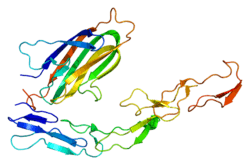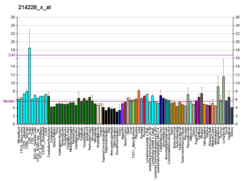CD134
Tumor necrosis factor receptor superfamily, member 4 (TNFRSF4), also known as CD134 and OX40 receptor, is a member of the TNFR-superfamily of receptors which is not constitutively expressed on resting naïve T cells, unlike CD28. OX40 is a secondary co-stimulatory immune checkpoint molecule, expressed after 24 to 72 hours following activation; its ligand, OX40L, is also not expressed on resting antigen presenting cells, but is following their activation. Expression of OX40 is dependent on full activation of the T cell; without CD28, expression of OX40 is delayed and of fourfold lower levels.
Function
OX40 has no effect on the proliferative abilities of CD4+ cells for the first three days, however after this time proliferation begins to slow and cells die at a greater rate, due to an inability to maintain a high level of PKB activity and expression of Bcl-2, Bcl-XL and survivin. OX40L binds to OX40 receptors on T-cells, preventing them from dying and subsequently increasing cytokine production. OX40 has a critical role in the maintenance of an immune response beyond the first few days and onwards to a memory response due to its ability to enhance survival. OX40 also plays a crucial role in both Th1 and Th2 mediated reactions in vivo.
OX40 binds TRAF2, 3 and 5 as well as PI3K by an unknown mechanism. TRAF2 is required for survival via NF-κB and memory cell generation whereas TRAF5 seems to have a more negative or modulatory role, as knockouts have higher levels of cytokines and are more susceptible to Th2-mediated inflammation. TRAF3 may play a critical role in OX40-mediated signal transduction. CTLA-4 is down-regulated following OX40 engagement in vivo and the OX40-specific TRAF3 DN defect was partially overcome by CTLA-4 blockade in vivo. TRAF3 may be linked to OX40-mediated memory T cell expansion and survival, and point to the down-regulation of CTLA-4 as a possible control element to enhance early T cell expansion through OX40 signaling.
Clinical significance
OX40 has been implicated in the pathologic cytokine storm associated with certain viral infections, including the H5N1 bird flu.
As a drug or drug target
An artificially created biologic fusion protein, OX40-immunoglobulin (OX40-Ig), prevents OX40 from reaching the T-cell receptors, thus reducing the T-cell response. Experiments in mice have demonstrated that OX40-Ig can reduce the symptoms associated with the cytokine storm (an immune overreaction) while allowing the immune system to fight off the virus successfully.
An anti-OX40 antibody GSK3174998 has started clinical trials as a cancer treatment.[5] Research in mice has included the combination of an agonistic OX40 antibody (clone OX86) injected directly into a tumor in combination with an unmethylated CpG oligonucleotide, which as a TLR9 ligand activates expression of OX40 so that it can be affected.[6]
References
- GRCh38: Ensembl release 89: ENSG00000186827 - Ensembl, May 2017
- GRCm38: Ensembl release 89: ENSMUSG00000029075 - Ensembl, May 2017
- "Human PubMed Reference:". National Center for Biotechnology Information, U.S. National Library of Medicine.
- "Mouse PubMed Reference:". National Center for Biotechnology Information, U.S. National Library of Medicine.
- "GSK and Merck to study immunotherapy combination as potential cancer treatment. Nov 2015". Archived from the original on 4 February 2017. Retrieved 6 April 2016.
- Sagiv-Barfi I, Czerwinski DK, Levy S, Alam IS, Mayer AT, Gambhir SS, Levy R (2018). "Eradication of spontaneous malignancy by local immunotherapy". Science Translational Medicine. 10 (426): eaan4488. doi:10.1126/scitranslmed.aan4488. ISSN 1946-6234. PMC 5997264. PMID 29386357.
- Kawamata S, Hori T, Imura A, Takaori-Kondo A, Uchiyama T (March 1998). "Activation of OX40 signal transduction pathways leads to tumor necrosis factor receptor-associated factor (TRAF) 2- and TRAF5-mediated NF-kappaB activation". The Journal of Biological Chemistry. 273 (10): 5808–14. doi:10.1074/jbc.273.10.5808. PMID 9488716.
- Arch RH, Thompson CB (January 1998). "4-1BB and Ox40 are members of a tumor necrosis factor (TNF)-nerve growth factor receptor subfamily that bind TNF receptor-associated factors and activate nuclear factor kappaB". Molecular and Cellular Biology. 18 (1): 558–65. doi:10.1128/MCB.18.1.558. PMC 121523. PMID 9418902.
External links
Further reading
- So T, Salek-Ardakani S, Nakano H, Ware CF, Croft M (April 2004). "TNF receptor-associated factor 5 limits the induction of Th2 immune responses". Journal of Immunology. 172 (7): 4292–7. doi:10.4049/jimmunol.172.7.4292. PMID 15034043.
- Song J, Salek-Ardakani S, Rogers PR, Cheng M, Van Parijs L, Croft M (February 2004). "The costimulation-regulated duration of PKB activation controls T cell longevity". Nature Immunology. 5 (2): 150–8. doi:10.1038/ni1030. PMID 14730361.
- Song J, So T, Cheng M, Tang X, Croft M (May 2005). "Sustained survivin expression from OX40 costimulatory signals drives T cell clonal expansion". Immunity. 22 (5): 621–31. doi:10.1016/j.immuni.2005.03.012. PMID 15894279.
- Croft M (August 2003). "Co-stimulatory members of the TNFR family: keys to effective T-cell immunity?". Nature Reviews. Immunology. 3 (8): 609–20. doi:10.1038/nri1148. PMID 12974476.
- Rogers PR, Song J, Gramaglia I, Killeen N, Croft M (September 2001). "OX40 promotes Bcl-xL and Bcl-2 expression and is essential for long-term survival of CD4 T cells". Immunity. 15 (3): 445–55. doi:10.1016/S1074-7613(01)00191-1. PMID 11567634.
- Watts TH (2005). "TNF/TNFR family members in costimulation of T cell responses". Annual Review of Immunology. 23: 23–68. doi:10.1146/annurev.immunol.23.021704.115839. PMID 15771565.





